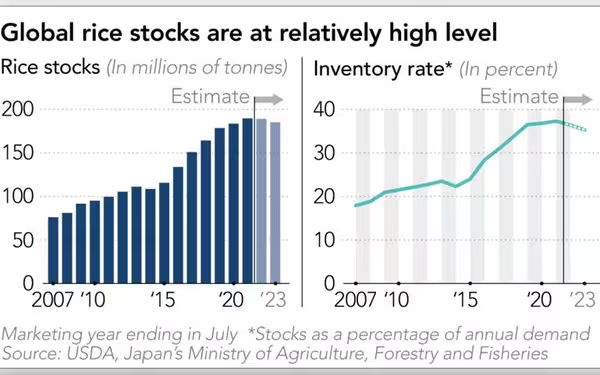Thursday, July 4, 2024 06:05 PM
Thailand leads rice price surge amid global market dynamics
- Thailand's 5% broken rice prices rise due to strong Indonesian demand
- India's rice rates stagnant despite ample supplies and subdued demand
- Bangladesh allows rice imports to stabilize elevated prices
 Image Credits: Nikkei Asia
Image Credits: Nikkei AsiaThis news piece discusses the fluctuating rice prices in key exporting countries like Thailand, India, Vietnam, and Bangladesh, influenced by demand, supply, and government actions.
Rice prices in key exporting countries have shown varied movements this week, reflecting the dynamics of demand and supply in the global market.
Thailand, a major rice exporter, witnessed a rise in prices for its 5% broken rice, reaching $585 to $590 per ton. This increase was driven by strong demand from Indonesia, with buyers also turning to Thailand, Vietnam, and Pakistan for their rice supplies.
On the other hand, India's rice rates remained near a two-month low, with the 5% broken parboiled variety quoted at $540-$548 per ton. The subdued demand from Asian and African buyers has contributed to the stagnation in Indian prices, despite sufficient local supplies.
Vietnam, another significant player in the rice market, maintained its 5% broken rice prices at $580 per metric ton. However, domestic paddy prices in Vietnam have started to rise slightly due to shrinking supplies and challenges such as saltwater intrusion in rice-producing regions.
Meanwhile, Bangladesh continues to grapple with elevated rice prices, despite good yields and ample reserves. To address this issue, the government has allowed private traders to import nearly 100,000 tonnes of rice in an effort to stabilize prices.
In conclusion, the global rice market is experiencing a mix of price movements influenced by factors such as demand from key importing countries, local supply conditions, and government interventions to manage prices. These developments highlight the interconnected nature of the rice trade and the importance of monitoring various factors to understand price trends in the market.













